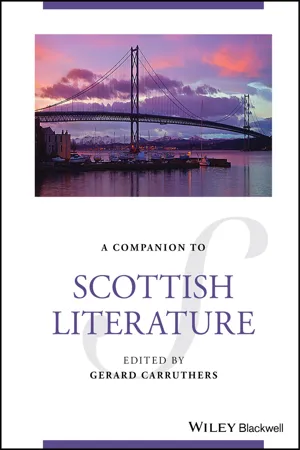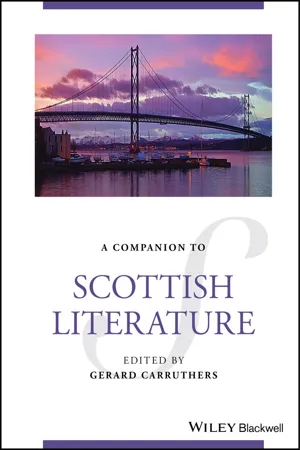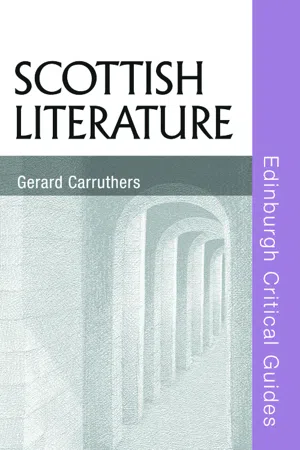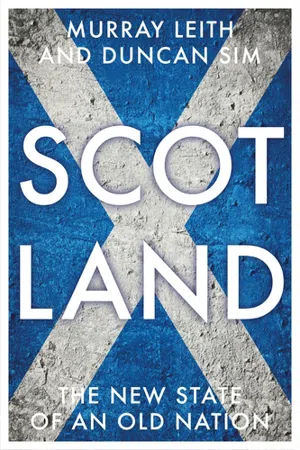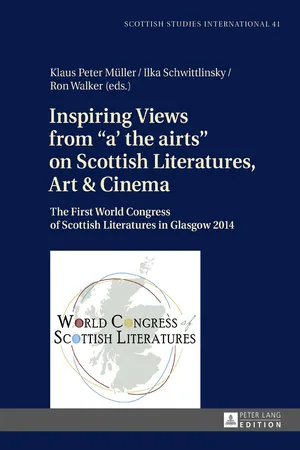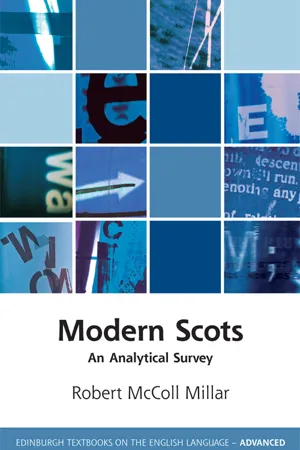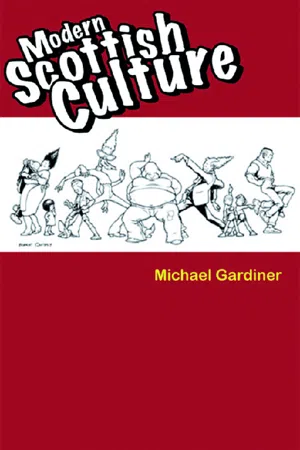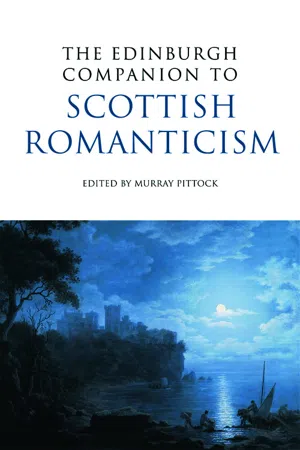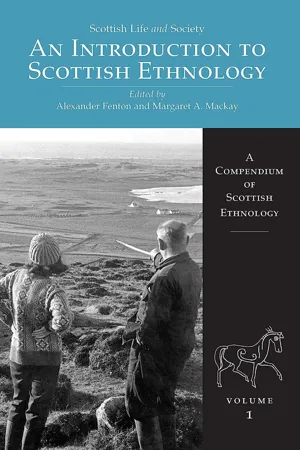Literature
Scottish Literature
Scottish literature encompasses the written and oral works produced by authors from Scotland or about Scottish themes. It includes a rich tradition of poetry, prose, and drama, with notable figures such as Robert Burns, Sir Walter Scott, and Irvine Welsh. Themes often revolve around Scottish identity, history, and landscape, reflecting the country's cultural and linguistic diversity.
Written by Perlego with AI-assistance
Related key terms
1 of 5
11 Key excerpts on "Scottish Literature"
- eBook - ePub
- Gerard Carruthers(Author)
- 2023(Publication Date)
- Wiley-Blackwell(Publisher)
1 Introduction: What is Scottish Literature?Gerard CarruthersSchool of Critical Studies, University of Glasgow, Glasgow, ScotlandDoes Scottish Literature exist as a subject‐area and a site of scholarly enquiry? Yes. Can we completely define what Scottish Literature is in one easy, wrap‐around definition? No.As this volume suggests, something that we might categorise under the label of ‘Scottish Literature’ has been with us for nearly one and a half millennia and no doubt there were forms of creative writing in Scotland even before that. There are hundreds of authors and thousands of texts since at least the sixth century that today, in the early twenty‐first century, we might – however problematically – classify within the ‘subject’ of Scottish Literature. As an area of study with a body of texts taught in schools and universities, Scottish Literature has particularly formed a somewhat distinctive identity within ‘Literatures in English’ since the 1960s at least. Distinctive but also related, however, as in a fairly large number of universities across the world, courses in Scottish Literature are usually taught from within departments of English Studies. The post‐1960s trend saw bold subject statements with the formation of the Association for Scottish Literature in 1970 and the first and so far only discrete Department of Scottish Literature at the University of Glasgow in 1971.1 From the second part of the twentieth century critical masses of scholars in the subject‐area were to be found in other Scottish universities, and indeed – increasingly from the 1980s – in lesser number in universities in Europe, North America and the Antipodes. Less densely again but noticeably, in the twenty‐first century, Scottish Literature scholars formally researching and teaching were to be found in South America and Asia, with a large amount of activity in China from around 2010 onwards. The scholarship of Scottish Literature, then, has a firm global footprint with the International Association for the Study of Scottish Literatures (IASSL) formed in 2014.2 - eBook - PDF
- Gerard Carruthers(Author)
- 2023(Publication Date)
- Wiley-Blackwell(Publisher)
‘It is about the English language rather than national identity’, we might be told by those who might wish to uphold the logic of the rubric, ‘English Literature’. Proponents of Scottish Literature, like other cognate literatures – such as Australian or American Literature – have sought to assert distinc- tiveness from English literature to a greater or lesser degree. Their desire has been to assert a measure of some, or all, of national, cultural, or political difference that makes sense of operating on an axis different from that of English literature. Along with such volition, we might objectively identify the difficulty basically of absorbing Scottish within a definition of English literature, when we observe rich, enduring seams of the literature produced in Scotland in the languages of Gaelic and Scots, such as feature frequently for critical consideration in the present volume. Such linguistic diversity, of course, makes the literature of Scotland not only difficult to be encompassed by English literature, but represents also a ‘Scottishness’ that is far from straightforward. Indeed, as shown in the literature of Scotland in the first millennium and beyond, we have writing as well as in English, Gaelic and Scots, in Anglo-Saxon, French, Latin, and Welsh too. Migratory patterns of people, languages, cul- ture and political entities obviously enough account for a lack of stability through time in ‘Scotland’ (not really any kind of larger kingdom or state until about a thousand years after the Romans had occupied much of the land). Something broadly similar about historically-shifting cultural expres- sion and identity might be said for many parts of the British and Irish isles. Cultural or national stability is often a rather over-determined notion, generated out of both good and bad human motives. - eBook - PDF
- Gerard Carruthers(Author)
- 2009(Publication Date)
- EUP(Publisher)
chapter 1 The Rise of Scottish Literature I n the last two decades of the twentieth century self-reflexive scrutiny of the discipline of ‘English Literature’ and ‘English Studies’ became a strongly marked feature in academic study. Within the framework of literary theory, this practice has sought to identify the ideological intent lying behind the rise of English as a subject in the nineteenth century, and its eventual supplanting of the classical humanities as the central arena in which literary criti-cism was conducted. 1 It is fairly obvious that canons, or selections of writers and texts for study on courses and in critical writing, are both inclusive and exclusive, and seek to narrate a cultural ‘story’. A narrative foregrounded in the ‘English’ label is that of one particu-lar nation among others in the British Isles, and yet English courses have long continued to include such ‘non-English’ writers as James Joyce, Dylan Thomas and Muriel Spark. Might it be, then, that ‘English’ refers primarily to a lingua franca ? And if this is the case, what is to be done, for example, with writing in Scots? Is this a different language from English or merely a ‘dialect’ of it? If it is the former, then presumably the need exists for a subject of ‘Scots Literature’? If it is the latter, then why have this dialect and its rich creative literature, along with many other dialects of English, been largely excluded from the study of English literature? In other words, in recent years schol-ars have worried over the dominant canonical logic lying behind English Literature and its comfortable narrowness, and one of the the rise of Scottish Literature 5 results has been the rise of courses in historically marginal areas of English, whether American, Australian, Canadian, Caribbean, Commonwealth, Irish, New Zealand or Scottish Literature (and lan-guage). - eBook - ePub
Scotland
The new state of an old nation
- Murray Stewart Leith, Duncan Sim(Authors)
- 2020(Publication Date)
- Manchester University Press(Publisher)
Scotland’s relatively small size also means that those involved in the cultural and creative industries are more connected with each other and with the government. Their importance may be seen by the fact that they contribute annually almost £3 billion to the Scottish economy and employ more than 63,000 people (Archer 2014). In this chapter, we explore various aspects of Scottish culture, including literature, language, music, theatre, film and art, and we also look at the Scottish Government’s cultural policies and how they are contributing to the nation’s sense of well-being, as well as its sense of identity. Literature It is not, of course, possible in a short chapter to discuss in detail Scotland’s literary history and this is covered much more extensively elsewhere (for example Crawford 2007). For many, the country’s earliest popular literature is focused on the poems of Robert Burns in the late eighteenth century and the Waverley novels of Sir Walter Scott in the early nineteenth. Both were writing at a time when Scotland was already part of the UK yet both wrote from a very distinctive Scottish standpoint. Burns’s poems were written primarily in the Scots language and Scott’s novels often deal with aspects of Scottish history, for example the Jacobite risings, with which the British state would not have been comfortable. Yet Scott managed to be relatively ambivalent in his novels, treating Scottish history in a rather nostalgic way and presenting the rebels as heroes of a culture that had actually vanished (Gardiner 2005). During the mid-nineteenth century, however, Gardiner (2005) suggests that there was a ‘deafening silence’ in Scottish Literature with writers such as Thomas Carlyle being very Anglocentric. Only with Robert Louis Stevenson was there something of a revival, although many of his stories, such as Kidnapped and its sequel Catriona, followed Scott in embracing a rather romanticised Scottish history - eBook - PDF
Inspiring Views from «a' the airts» on Scottish Literatures, Art and Cinema
The First World Congress of Scottish Literatures in Glasgow 2014
- Klaus Peter Müller, Ilka Schwittlinsky, Ron Walker(Authors)
- 2017(Publication Date)
- Peter Lang Group(Publisher)
It is insular too: “of, pertaining to, the islands”. The experience of Scottish Literature’s treatment by the metropolis has taught us – or should have taught us – to be wary of such terms as peripheral or remote, and to remember that ‘the centre’ is not where you are not, but where you are. A literature not of one language – the rich, wonderful language that is English – but of three at least, is a blest literature. The Gaelic and Scots influences on Scottish writing in English are varied and continuing. A re- cent publication from Freight, a young publishing house here in Glasgow, entitled A Bird is not a Stone, is an anthology of contemporary Palestinian poetry from twenty-five poets, printed in Arabic with translations in Eng- lish, Scots and Gaelic (Lochhead 2014). A very engaging and enterprising addition to Scots reference books is a Scots-Polish Lexicon (Michalska 2014), also published this year, compiled by Kasia Michalska, a Polish teacher living in Edinburgh. Part of her motivation for producing such a book, which is trilingual as it bridges the other two languages with English, was that she was conscious that many of her compatriots arrive in Scotland under the mistaken impression that they are coming to an English-speaking country. James Robertson 28 So, we have languages. We have a continuing high level of literary activity, despite many problems in our publishing and bookselling in- frastructure and the challenges of rapidly changing technology and new means of access. So far, so good. Will it last? Shall there be a Scottish Literature? In William Dunbar’s great roll-call of the dead poets of his age, the ‘Lament for the Makars’, we have a salutary reminder that the majority of those writing at any one time are destined for obscurity. That’s okay. Actually it is healthy: it is the very existence of all those writers and their writing, that energy of many and multiple voices, that demonstrates that something is going on. - eBook - PDF
Modern Scots
An Analytical Survey
- Robert McColl Millar(Author)
- 2018(Publication Date)
- Edinburgh University Press(Publisher)
160 6 Scots used creatively: literature and beyond 1 6.1 Introduction In terms of reputation in world literature, Scotland punches well above its weight. Figures such as Robert Burns, Sir Walter Scott, Robert Louis Stevenson and Muriel Spark are world-renowned, their work translated into a range of languages and read by an audience who may not have a full grasp of where and what Scotland is (I cannot be the only person who has winced when hearing Hugh MacDiarmid referred to as an ‘English poet’). From my own experience I can say that Robert Burns has touched lives lived well beyond Europe in ways that few other writers have done. With at least some Scottish writers, the language used has played a profound part in the attraction of the work – poetry, prose and drama – produced by Scottish writers over the last 200 years or so. It should be noted from the outset, however, that many of the most celebrated Scottish writers – Muriel Spark is a particularly good example of this – rarely use Scots in their work; if they do, this tends to act as a patina of local colouring rather than as a central part of the novel’s essence. To some extent this may be due to an author’s coming from a middle-class urban background, although writers like William McIlvanney and Alan Spence, both from working-class backgrounds, also use a rather limited amounts of Scots in their work, even in dia-logue. This issue is compounded, of course, in those circumstances where, absolutely legitimately, Scottish writers place the action of their writing outside of Scotland. 6.2 Scots in an English prose context This book is concerned with Modern Scots. Nevertheless, in order to have a sense of the norms in relation to the use of Scots in Scottish Literature, we need to look back at least until the second-half of the eighteenth century to establish what has formed present practice. SCOTS USED CREATIVELY : LITERATURE AND BEYOND 161 Let us consider in the first instance the use of Scots in fictional prose. - eBook - PDF
- Michael Gardiner(Author)
- 2019(Publication Date)
- Edinburgh University Press(Publisher)
known and bound by Eng. Lit.-style rules. The modes of writing that are seen as most ‘literary’ tend still to be the favourites of that most British discipline of English Literature, which developed along with empire. And from the viewpoint of the small nation, if some genres are seen to represent ‘real’, ‘immediate’ experience more than others (as some contemporary Scottish novelists have claimed), we are still not in a healthy literary environment. Ironically, the Scottish Enlightenment, which helped set up the now-suspect discipline of English Literature, is a prime example of such an inter-disciplinary environment: describing David Hume as a literary fi gure would have raised no eyebrows in . Today’s secondary reading, then, could be tomorrow’s primary reading, and vice-versa. The point is, if there was a normal mutual in fl uence and ideas circulated beyond the ‘primary’, as in eighteenth-century Scotland or twentieth-century France, it might not be neces-sary to stack all bets on a generation of saleable novelists, as Scotland tends to do. This chapter is neither an explanation for, nor a criticism of, the internationally known names or those of previous generations, and does not include examples of writing. For this, you should turn to the excellent Scottish Literature , edited by Gi ff ord, Dunnigan and MacGillivaray, which has about , pages more to spare than I do here. Here I suggest something di ff erent, by speculating on the con-ditions necessary for a healthy literary culture, and holding up Scottish writing against this speculation. As many commentators have recently shown, there is a seam of anti-intellectualism in the English aspect of Eng. Lit.’s conception of genre, centred on poetry, which has been a guarantor of ‘good’ English, and has served England well in its centrality to empire. - eBook - ePub
Beside the Bard
Scottish Lowland Poetry in the Age of Burns
- George S. Christian(Author)
- 2020(Publication Date)
- Bucknell University Press(Publisher)
It is not simply a matter of language or locale. It takes more than a Scottish birth-certificate, or a vocabulary sprinkled with Scotticisms, to make a Scottish poet. It is all those intangible influences—religious, historical, educational, aesthetic, geographical, linguistic, literary, and broadly cultural—which work together to determine national and individual character.” 31 For Scott, “Scottishness” evokes multiple bases of Scottish identity, speaking at once to the political and communal “nation” and to the ubiquitous Scottish presence in world culture. From this perspective, Scottishness constructs a kind of universal category available to anyone linked to Scotland by virtue of “broadly cultural” interpenetration. What makes Scottishness so “stubborn,” perhaps, is its refusal of signification within any standard geopolitical terminology. No one knows exactly what constitutes Scotland or Scottishness, certainly not in the way we understand the constitution of England or the United States. When Robert Crawford, for example, retails the story of Mario Vargas Llosa’s journey to Kirkcaldy and Abbotsford in search of Adam Smith and Walter Scott (citizens of the world if there ever were any), he does it to show the profound influence of Scottish Literature on the wider world, as well as the immense culture industry that nineteenth-century Scotland has produced for world consumption. 32 In addition to its other presences, both concrete and evanescent, Scotland might be said to exist as a kind of corporate entity engaged in global commerce, an entity that, lacking political sovereignty, has nevertheless established a “nation” sustained by an aggressively marketed national culture - Murray Pittock(Author)
- 2011(Publication Date)
- EUP(Publisher)
The literary productions of this period celebrate and curate the past, something also realised in efforts of collection and the publication of anthologies. These in turn produced a new critical mode, and the evolution of selectivity and taste. Despite this, the literature itself is, up to the early nineteenth century, only in rather particular ways inflected by Scots and English literary influences – a prominent and pervasive example might be the Scots and English songs whose tunes formed the ground on which poets built their works. The aesthetics largely conform to Gaelic modes, even when they are at their most innovative – witness the development of the experimental long poem based on the musical variants of pipe music by both Alasdair mac Mhaighstir Alasdair and Donnchadh Bàn Mac an t-Saoir. 22 And even whilst foregrounding certain stances and themes that might be seen as typical of Romantic literature, for instance, the narrative monologue, praise of nature, nostalgia for the places and people of the past, romantic love within a wild setting, these draw, as we have already noted, on very long pedigrees within Gaelic literary tradition. The period of concentration is best book-ended by two crucial publica-tions, each of which illustrate some of the transformations and tenden-cies that concern us. The year 1751 saw the publication by Alasdair mac Mhaighstir Alasdair of his Ais-eiridh na Sean Chánoin Albannaich . This was the first secular book to be published in Gaelic, a collection of poems by the poet himself that were bold, innovative, racy and provocative. As Ronald Black makes clear, 24 the book was dangerous, containing obscenity and sedi-tion, alongside and within its riveting poetry. At one level his poems may be read against the political turbulence of the previous decades, and they certainly foreground, as well encode, Jacobite views.- eBook - ePub
- Derick S. Thomson, Ian Grimble(Authors)
- 2021(Publication Date)
- Routledge(Publisher)
Literature and the ArtsDerick S. ThomsonLiterature and the Arts
The position of literature and the arts in Gaelic Scotland is affected by the structure of Gaelic society and by the society’s economic strength. Public attitudes are coloured by the religious and dogmatic principles which inform the society, or part of it. The minority status of the Gaelic language and culture has repercussions on the range and the nature of the work that is done in the various artistic media. Historical events and attitudes still exercise a profound influence on all these matters, and on the texture of life in general in the Gaelic area of Scotland, or more widely, in Scotland’s Gaelic community.Aspects of these topics have been discussed in the Introduction and in the preceding chapters, so that the reader already has in his mind many facts and opinions that will help to fill out the background to this chapter. He will know something of the historical causes of the Gaelic community’s minority status, the size and distribution of that community, the economic status of the Gaelic area, the educational pattern in the recent past and at the present time. It will already be clear that this Gaelic society is one which lacks the normal structure on which literary activity and artistic organisation are based in modern communities, although it still retains, in a fragmentary form, the archaic structure on which various kinds of artistic achievement were built in earlier times. Thus the oral literary tradition still retains some vitality, although the half-hearted way in which the educational system has come to terms with the native culture often has the effect of depriving the people of the best of both worlds.Literature and the arts need some form of patronage, however flexibly we may define ‘patronage’. At one extreme, that of truly popular generation, patronage is perhaps too well-defined a word to describe the generating impulse. Here it might be truer simply to say that literature and the arts need a public or an audience: the popular audience is the patron in this case. But in any highly organised society the artist tends to be supported directly or indirectly. He is supported directly by commissions, sales, office. But sometimes his support is largely a moral and intangible one: he is set aside from the community, and given a status or prestige which derives from his occupation. He goes about earning his living in other ways, as a civil servant or a bank clerk, and produces art in response, partly at least, to this intangible stimulus. - eBook - ePub
An Introduction To Scottish Ethnology
A Compendium of Scottish Ethnology Volume 1
- Alexander Fenton, Margaret A. Mackay, Alexander Fenton(Authors)
- 2013(Publication Date)
- Birlinn(Publisher)
Here, on the whole, written evidence is used as contextual, historical or parallel, rather than complementary, forms of information about traditional material. Storytelling and written narrative are approached as separate sources that occasionally meet. There are of course exceptions, such as considerations of oral and written intersections in the work of Burns, or recent treatments of the way that poetry, ballads and chapbook literature inform Scottish Romanticism, particularly that of Scott. 6 This leaves some leeway for the development of new approaches to writers hitherto neglected by folklorists. For reasons of space, my focus here is on authors working within the physical nation, writing in Scots and English but excluding Gaelic writing except where – as in the Ossianic translations of James Macpherson – there are crossovers. Non-fictional contexts, including memoirs and purpose-made collections, are excluded, along with evidence in song, theatre and film scripts. Another area not discussed is the verbal aspects of interactive storytelling in new media contexts – a new way of communicating and creating traditions. 7 POETRY From the Middle Ages onwards, poetry in Scots and English has provided an extremely rich resource for ethnological investigation. ‘The Dream of the Rood’, carved in runic script on the Ruthwell Cross in Dumfries and Galloway in the eighth century is the earliest written example of the ancestral (to Scots) Northern Anglo-Saxon that was then spoken. 8 As the rood speaks, there is an indication of very vividly held Christian beliefs at the period of its generation, framed within contemporary social structures. Christ is envisaged as a king, dethroned and mocked by misguided warriors and nobles; the cross stands firm to support Christ in his misery
Index pages curate the most relevant extracts from our library of academic textbooks. They’ve been created using an in-house natural language model (NLM), each adding context and meaning to key research topics.
